2009 Hyundai Getz change wheel
[x] Cancel search: change wheelPage 81 of 191
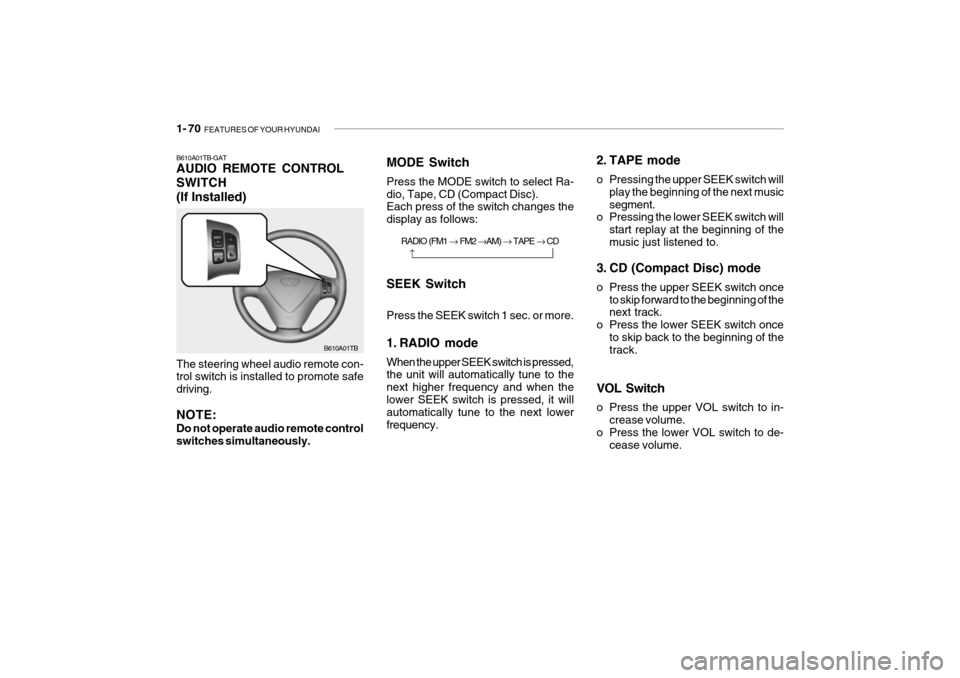
1- 70 FEATURES OF YOUR HYUNDAI
Press the SEEK switch 1 sec. or more.
1. RADIO mode When the upper SEEK switch is pressed, the unit will automatically tune to the next higher frequency and when thelower SEEK switch is pressed, it will automatically tune to the next lower frequency.
MODE Switch Press the MODE switch to select Ra- dio, Tape, CD (Compact Disc). Each press of the switch changes the display as follows:
RADIO (FM1 � FM2 �AM) � TAPE � CD
SEEK Switch
B610A01TB-GAT AUDIO REMOTE CONTROL SWITCH(If Installed) The steering wheel audio remote con- trol switch is installed to promote safe driving. NOTE: Do not operate audio remote control switches simultaneously. B610A01TB
�
2. TAPE mode
o Pressing the upper SEEK switch will
play the beginning of the next music segment.
o Pressing the lower SEEK switch will
start replay at the beginning of themusic just listened to.
3. CD (Compact Disc) mode
o Press the upper SEEK switch once to skip forward to the beginning of the next track.
o Press the lower SEEK switch once to skip back to the beginning of thetrack.
VOL Switch
o Press the upper VOL switch to in- crease volume.
o Press the lower VOL switch to de-
cease volume.
Page 102 of 191
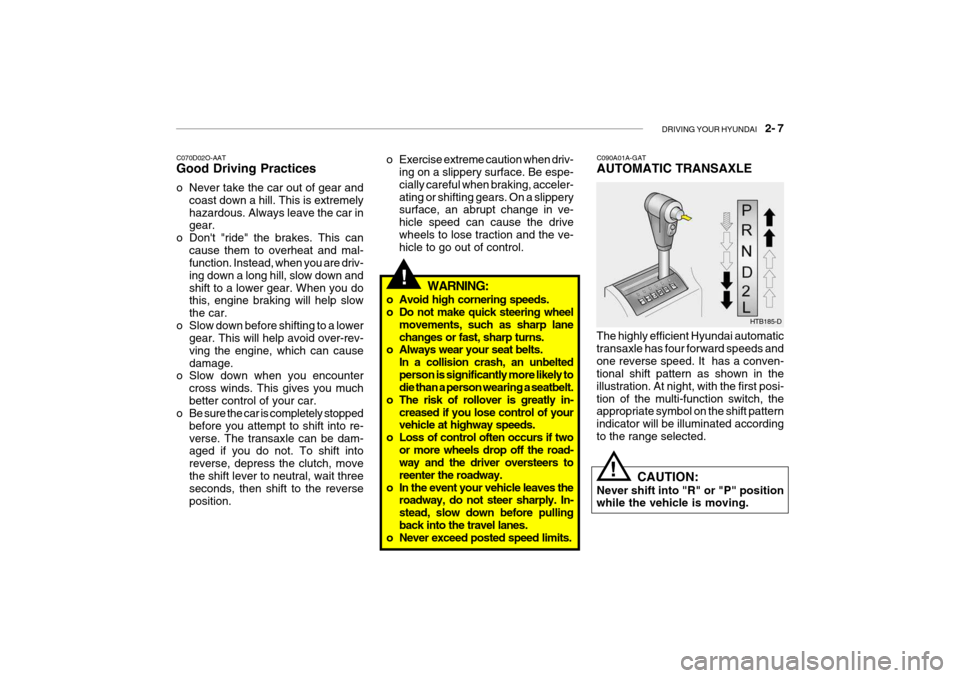
DRIVING YOUR HYUNDAI 2- 7
!
o Exercise extreme caution when driv-
ing on a slippery surface. Be espe- cially careful when braking, acceler-ating or shifting gears. On a slippery surface, an abrupt change in ve- hicle speed can cause the drivewheels to lose traction and the ve- hicle to go out of control.
C070D02O-AAT Good Driving Practices
o Never take the car out of gear and
coast down a hill. This is extremely hazardous. Always leave the car in gear.
o Don't "ride" the brakes. This can
cause them to overheat and mal-function. Instead, when you are driv- ing down a long hill, slow down andshift to a lower gear. When you do this, engine braking will help slow the car.
o Slow down before shifting to a lower gear. This will help avoid over-rev-ving the engine, which can causedamage.
o Slow down when you encounter
cross winds. This gives you muchbetter control of your car.
o Be sure the car is completely stopped
before you attempt to shift into re-verse. The transaxle can be dam- aged if you do not. To shift into reverse, depress the clutch, movethe shift lever to neutral, wait three seconds, then shift to the reverse position. HTB185-D
C090A01A-GAT AUTOMATIC TRANSAXLE
The highly efficient Hyundai automatic transaxle has four forward speeds andone reverse speed. It has a conven- tional shift pattern as shown in the illustration. At night, with the first posi-tion of the multi-function switch, the appropriate symbol on the shift pattern indicator will be illuminated accordingto the range selected. CAUTION:
Never shift into "R" or "P" position while the vehicle is moving.
!
WARNING:
o Avoid high cornering speeds.
o Do not make quick steering wheel movements, such as sharp lane changes or fast, sharp turns.
o Always wear your seat belts.
In a collision crash, an unbeltedperson is significantly more likely to die than a person wearing a seatbelt.
o The risk of rollover is greatly in-
creased if you lose control of yourvehicle at highway speeds.
o Loss of control often occurs if two
or more wheels drop off the road-way and the driver oversteers to reenter the roadway.
o In the event your vehicle leaves the roadway, do not steer sharply. In-stead, slow down before pullingback into the travel lanes.
o Never exceed posted speed limits.
Page 105 of 191
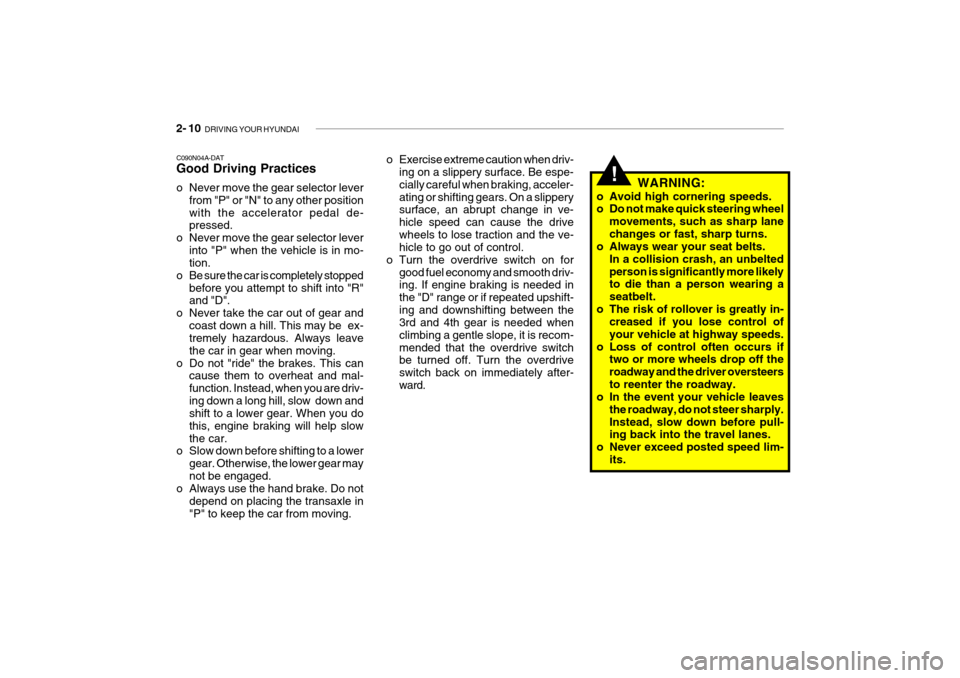
2- 10 DRIVING YOUR HYUNDAI
!
C090N04A-DAT Good Driving Practices
o Never move the gear selector lever
from "P" or "N" to any other position with the accelerator pedal de- pressed.
o Never move the gear selector lever
into "P" when the vehicle is in mo-tion.
o Be sure the car is completely stopped before you attempt to shift into "R"and "D".
o Never take the car out of gear and coast down a hill. This may be ex-tremely hazardous. Always leave the car in gear when moving.
o Do not "ride" the brakes. This can cause them to overheat and mal-function. Instead, when you are driv-ing down a long hill, slow down and shift to a lower gear. When you do this, engine braking will help slowthe car.
o Slow down before shifting to a lower
gear. Otherwise, the lower gear maynot be engaged.
o Always use the hand brake. Do not
depend on placing the transaxle in"P" to keep the car from moving. o Exercise extreme caution when driv-
ing on a slippery surface. Be espe-cially careful when braking, acceler-ating or shifting gears. On a slippery surface, an abrupt change in ve- hicle speed can cause the drivewheels to lose traction and the ve- hicle to go out of control.
o Turn the overdrive switch on for good fuel economy and smooth driv-ing. If engine braking is needed in the "D" range or if repeated upshift-ing and downshifting between the 3rd and 4th gear is needed when climbing a gentle slope, it is recom-mended that the overdrive switch be turned off. Turn the overdrive switch back on immediately after-ward. WARNING:
o Avoid high cornering speeds.
o Do not make quick steering wheel movements, such as sharp lane changes or fast, sharp turns.
o Always wear your seat belts.
In a collision crash, an unbeltedperson is significantly more likely to die than a person wearing a seatbelt.
o The risk of rollover is greatly in- creased if you lose control ofyour vehicle at highway speeds.
o Loss of control often occurs if two or more wheels drop off theroadway and the driver oversteersto reenter the roadway.
o In the event your vehicle leaves
the roadway, do not steer sharply.Instead, slow down before pull- ing back into the travel lanes.
o Never exceed posted speed lim- its.
Page 109 of 191

2- 14 DRIVING YOUR HYUNDAI
C140A01A-DAT DRIVING FOR ECONOMY You can save fuel and get more kilo- meters from your car if you followthese suggestions:
o Drive smoothly. Accelerate at a
moderate rate. Don't make "kanga- roo" starts or full-throttle shifts. Maintain a steady cruising speed.Don't race between stoplights. Try to adjust your speed to that of the other traffic so you don't have tochange speeds unnecessarily. Avoid heavy traffic whenever possible. Always maintain a safe distancefrom other vehicles so you can avoid unnecessary braking. This also reduces brake wear.
o Drive at a moderate speed. The faster you drive, the more fuel yourcar uses. Driving at a moderatespeed, especially on the highway, is one of the most effective ways to reduce fuel consumption.
o Don't "ride" the brake. This can in- crease fuel consumption and alsoincrease wear on this components. o In addition, driving with your foot
resting on the brake pedal may causethe brakes to overheat, which re-duces their effectiveness and may
lead to more serious consequences.
o Take care of your tyres. Keep them inflated to the recommended pres-sure. Incorrect inflation, either too much or too little, results in unnec-essary tyre wear. Check the tyre pressures at least once a month.
o Be sure that the wheels are aligned correctly. Improper alignment canresult from hitting curbs or driving too fast over irregular surfaces Pooralignment causes faster tyre wear and may also result in other prob- lems as well as greater fuel con-sumption.
o Keep your car in good condition. For
better fuel economy and reducedmaintenance costs, maintain your car in accordance with the mainte- nance schedule in Section 5. If youdrive your car in severe conditions, more frequent maintenance is re- quired (see Section 5 for details).
C310D01JM-AAT Indicators and Warning The indicators should illuminate when the ignition key is turned to ON orSTART but should go out after three seconds. If the indicators do not illuminate, or theESP or ESP-OFF indicator does not go out after 3 seconds, have the vehicle checked by an authorized dealer. Should there be any unusual conditions in the device while driving, ESP-OFFindicator illuminates as a warning. If ESP-OFF indicator illuminates, pull your car to a safe place and stop theengine. Then, start the engine again to check if the ESP-OFF indicator goes out. If the indicator remains lit even after the engine has been started, have your carchecked by an authorized Hyundai dealer.
Page 116 of 191

DRIVING YOUR HYUNDAI 2- 21
14. When going down a hill, shift into a
lower gear and use the engine brak- ing effect. When ascending a longgrade, downshift the transmission to a lower gear and reduce speed to reduce chances of engine over-loading and/or overheating.
15.If you have to stop while going
uphill, do not hold the vehicle inplace by pressing on the accelera- tor. This can cause the automatic transmission to overheat. Use thehand brake or footbrake.
NOTE: When towing, check transaxle fluid more frequently. 1. Turn off the air conditioner.
2. Reduce highway speed.
3. Select a lower gear when going up-
hill.
4. While in stop and go traffic, place
the gear selection in park or neutraland idle the engine at a higher speed.
CAUTION:
If overheating should occur whentowing, (temperature gauge reads near red zone), taking the following action may reduce or eliminate theproblem.
!
8. When parking your car and trailer,
especially on a hill, be sure to follow all the normal precautions. Turnyour front wheel into the curb, set the hand brake firmly, and put the transmission in 1st or Reverse(manual) or Park (automatic). In addition, place wheel chocks at each of the trailer's tyres.
9. If the trailer has electric brakes, drive your vehicle with the trailerattached, and then apply the trailerbrakes by hand. This test confirms the operation of the trailer brakes and also checks your electrical con-nection at the same time.
10.During your trip, check occasion-
ally to be sure that the load issecure, and that the lights and any trailer brakes are still working.
11.Avoid jerky starts, sudden accel- eration or sudden stops.
12.Avoid sharp turns and rapid lane
changes.
13.Avoid holding the brake pedal down too long or too frequently. This could cause the brakes to overheat, re-sulting in reduced braking efficiency. D120A02A-DAT IF YOU LOSE YOUR KEYS If you happen to lose your leys, your vehicle will require towing to your Hyundai dealer to have the new set ofkeys programmed to your vehicle.
Page 122 of 191
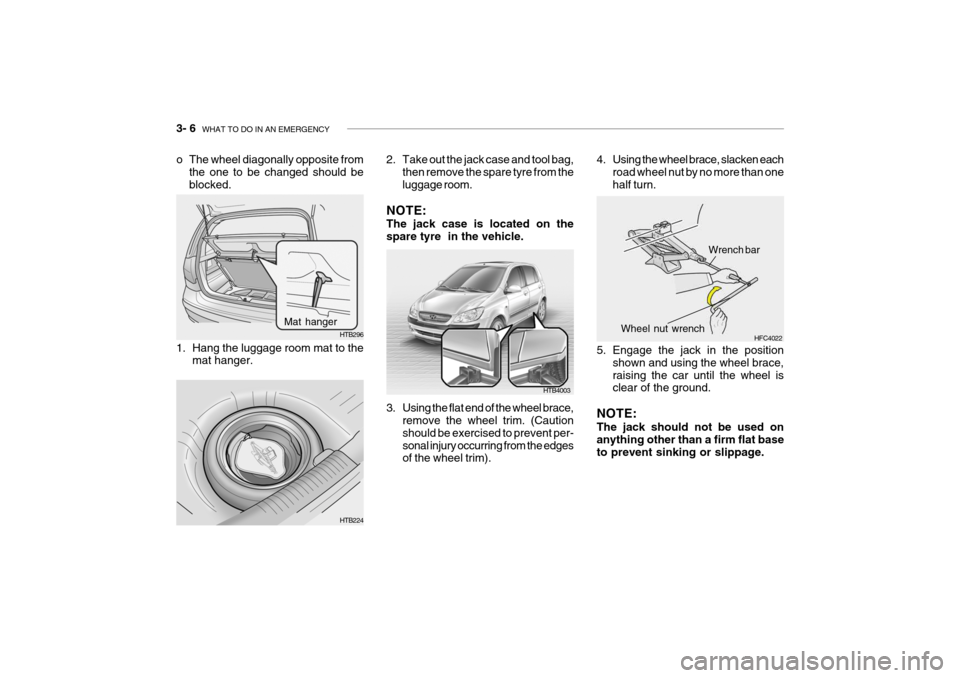
3- 6 WHAT TO DO IN AN EMERGENCY
o The wheel diagonally opposite from
the one to be changed should be blocked.
HTB224
HTB296
Mat hanger
1. Hang the luggage room mat to the mat hanger. 2. Take out the jack case and tool bag,
then remove the spare tyre from the luggage room.
NOTE: The jack case is located on the spare tyre in the vehicle.
3. Using the flat end of the wheel brace, remove the wheel trim. (Caution should be exercised to prevent per-sonal injury occurring from the edges of the wheel trim). HTB40034. Using the wheel brace, slacken each
road wheel nut by no more than one half turn.
5. Engage the jack in the position shown and using the wheel brace,raising the car until the wheel is clear of the ground.
NOTE: The jack should not be used on anything other than a firm flat base to prevent sinking or slippage.
HFC4022
Wrench bar
Wheel nut wrench
Page 158 of 191
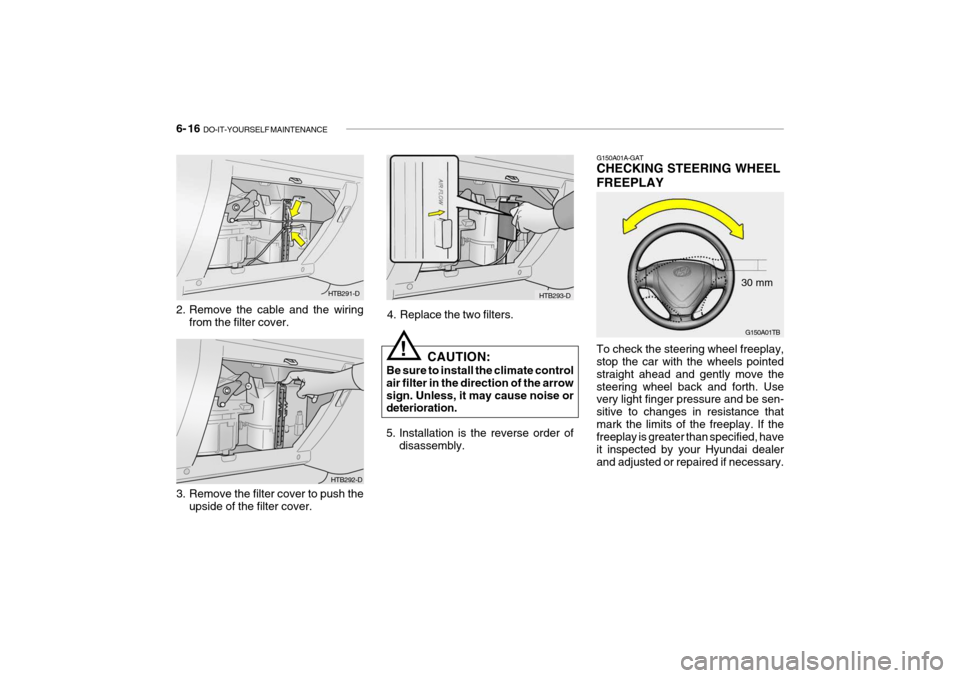
6- 16 DO-IT-YOURSELF MAINTENANCE
G150A01A-GAT CHECKING STEERING WHEEL FREEPLAY To check the steering wheel freeplay, stop the car with the wheels pointed straight ahead and gently move thesteering wheel back and forth. Use very light finger pressure and be sen- sitive to changes in resistance thatmark the limits of the freeplay. If the freeplay is greater than specified, have it inspected by your Hyundai dealerand adjusted or repaired if necessary. G150A01TB
30 mm
HTB293-D
4. Replace the two filters.
CAUTION:
Be sure to install the climate controlair filter in the direction of the arrowsign. Unless, it may cause noise or deterioration.
5. Installation is the reverse order of disassembly.
!
HTB291-D
2. Remove the cable and the wiring from the filter cover.
HTB292-D
3. Remove the filter cover to push the upside of the filter cover.
Page 181 of 191
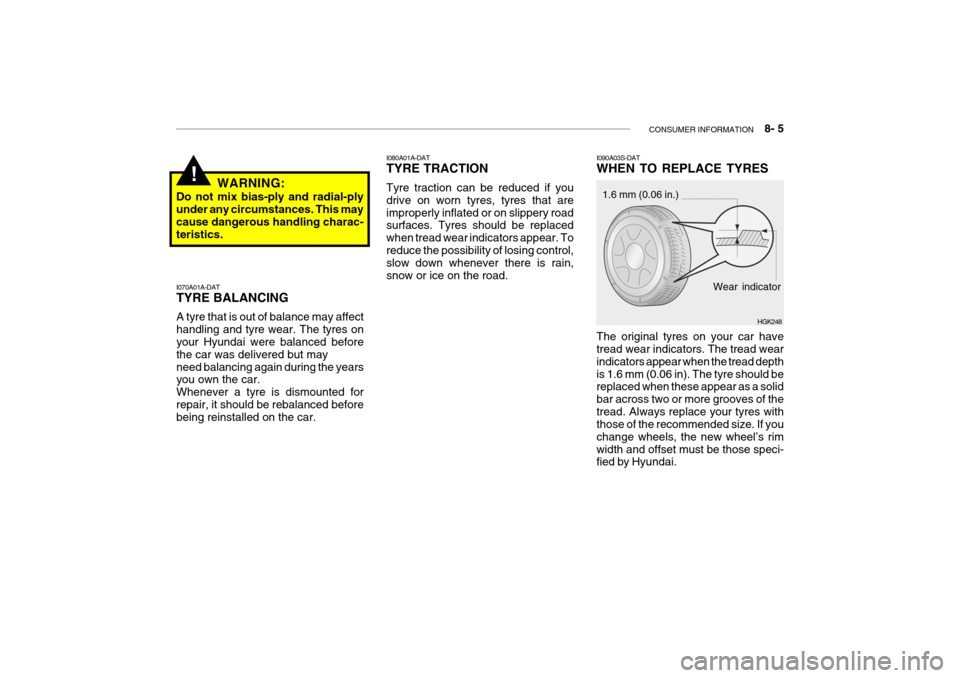
CONSUMER INFORMATION 8- 5
!
I070A01A-DAT TYRE BALANCING A tyre that is out of balance may affect handling and tyre wear. The tyres on your Hyundai were balanced before the car was delivered but mayneed balancing again during the years you own the car. Whenever a tyre is dismounted forrepair, it should be rebalanced before being reinstalled on the car. I080A01A-DAT TYRE TRACTION Tyre traction can be reduced if you drive on worn tyres, tyres that areimproperly inflated or on slippery road surfaces. Tyres should be replaced when tread wear indicators appear. Toreduce the possibility of losing control, slow down whenever there is rain, snow or ice on the road.
I090A03S-DAT WHEN TO REPLACE TYRESWear indicator
1.6 mm (0.06 in.)
HGK248
WARNING:
Do not mix bias-ply and radial-ply under any circumstances. This may cause dangerous handling charac-teristics.
The original tyres on your car have tread wear indicators. The tread wear indicators appear when the tread depthis 1.6 mm (0.06 in). The tyre should be replaced when these appear as a solid bar across two or more grooves of thetread. Always replace your tyres with those of the recommended size. If you change wheels, the new wheel’s rimwidth and offset must be those speci- fied by Hyundai.